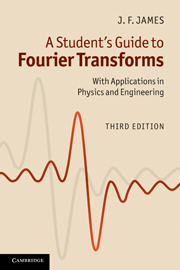Book contents
- Frontmatter
- Contents
- Preface to the first edition
- Preface to the second edition
- Preface to the third edition
- 1 Physics and Fourier transforms
- 2 Useful properties and theorems
- 3 Applications 1: Fraunhofer diffraction
- 4 Applications 2: signal analysis and communication theory
- 5 Applications 3: interference spectroscopy and spectral line shapes
- 6 Two-dimensional Fourier transforms
- 7 Multi-dimensional Fourier transforms
- 8 The formal complex Fourier transform
- 9 Discrete and digital Fourier transforms
- Appendix
- Bibliography
- Index
1 - Physics and Fourier transforms
Published online by Cambridge University Press: 05 June 2012
- Frontmatter
- Contents
- Preface to the first edition
- Preface to the second edition
- Preface to the third edition
- 1 Physics and Fourier transforms
- 2 Useful properties and theorems
- 3 Applications 1: Fraunhofer diffraction
- 4 Applications 2: signal analysis and communication theory
- 5 Applications 3: interference spectroscopy and spectral line shapes
- 6 Two-dimensional Fourier transforms
- 7 Multi-dimensional Fourier transforms
- 8 The formal complex Fourier transform
- 9 Discrete and digital Fourier transforms
- Appendix
- Bibliography
- Index
Summary
The qualitative approach
Ninety percent of all physics is concerned with vibrations and waves of one sort or another. The same basic thread runs through most branches of physical science, from acoustics through engineering, fluid mechanics, optics, electromagnetic theory and X-rays to quantum mechanics and information theory. It is closely bound to the idea of a signal and its spectrum. To take a simple example: imagine an experiment in which a musician plays a steady note on a trumpet or a violin, and a microphone produces a voltage proportional to the instantaneous air pressure. An oscilloscope will display a graph of pressure against time, F(t), which is periodic. The reciprocal of the period is the frequency of the note, 440 Hz, say, for a well-tempered middle A – the tuning-up frequency for an orchestra.
The waveform is not a pure sinusoid, and it would be boring and colourless if it were. It contains ‘harmonics’ or ‘overtones’: multiples of the fundamental frequency, with various amplitudes and in various phases, depending on the timbre of the note, the type of instrument being played and on the player. The waveform can be analysed to find the amplitudes of the overtones, and a list can be made of the amplitudes and phases of the sinusoids which it comprises. Alternatively a graph, A(ν), can be plotted (the sound-spectrum) of the amplitudes against frequency (Fig. 1.1).
- Type
- Chapter
- Information
- A Student's Guide to Fourier TransformsWith Applications in Physics and Engineering, pp. 1 - 19Publisher: Cambridge University PressPrint publication year: 2011
- 1
- Cited by



